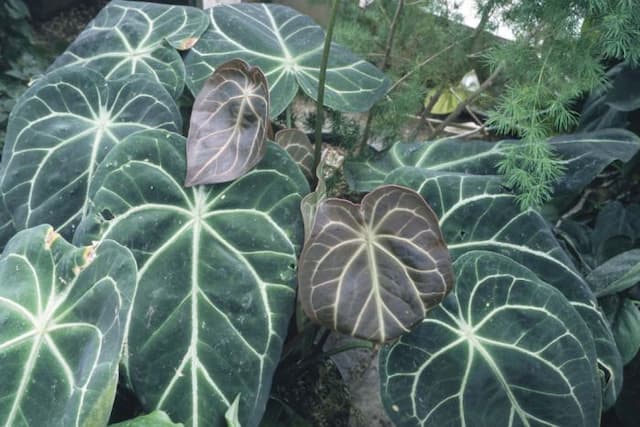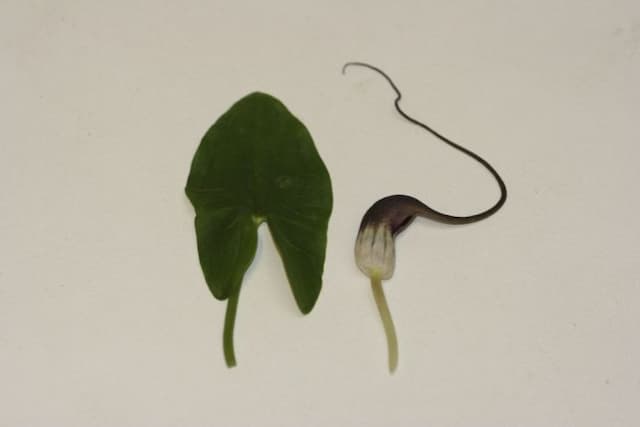Calla Lily 'Memories' Zantedeschia 'Memories' (PBR)

ABOUT
Zantedeschia 'Memories' (PBR), more commonly referred to as the calla lily 'Memories', is a striking perennial plant known for its unique and elegant blooms. The plant bears a luxurious and glossy spade-like foliage that provides a lush, green backdrop to its flowers. The leaves are deep green with a smooth texture and sometimes feature lighter spots or markings, which add visual interest to the plant. The calla lily 'Memories' is most celebrated for its sophisticated flower form. The blooms comprise of a flaring trumpet-shaped spathe—a modified leaf that looks like a flower petal—which wraps around a central, finger-like spadix. The spathe is creamy-white with a soft blush of pink-purple, giving it an air of refined beauty and serenity. This subtle color transition grants the plant an artistic charm. The flowers are graceful and attractive, often used in floral arrangements and highly desired for their aesthetic appeal. The calla lily 'Memories' expresses its full beauty when in bloom, radiating elegance and a sense of tranquility, which makes it a beloved choice for gardens, patios, and as a cut flower in bouquets.
About this plant
 Names
NamesFamily
Araceae
Synonyms
Calla Lily, Arum Lily
Common names
Zantedeschia 'Memories' (PBR)
 Toxicity
ToxicityTo humans
Calla Lily 'Memories' (Zantedeschia 'Memories') is considered toxic to humans due to the presence of calcium oxalate crystals. If ingested, these sharp crystals can cause a burning sensation in the mouth and throat, swelling of the lips, tongue, and throat, difficulty swallowing, vomiting, and diarrhea. Contact with the sap may also cause skin irritation. It is important to handle this plant with care and to keep it out of the reach of children, who may be tempted to ingest it.
To pets
Calla Lily 'Memories' (Zantedeschia 'Memories') is toxic to pets, including cats and dogs, due to calcium oxalate crystals. When any part of the plant is ingested by a pet, the animal may experience oral irritation, intense burning and irritation of mouth, tongue, and lips, excessive drooling, vomiting, and difficulty swallowing. In severe cases, ingestion can lead to dehydration and other symptoms due to the difficulty in swallowing and potential for vomiting. It is important to prevent pets from accessing this plant to avoid the risk of poisoning.
 Characteristics
CharacteristicsLife cycle
Perennials
Foliage type
Evergreen
Color of leaves
Green
Flower color
White
Height
2 feet (60 cm)
Spread
1 foot (30 cm)
Plant type
Herb
Hardiness zones
8
Native area
Africa
Benefits
 General Benefits
General Benefits- Easy to Grow: 'Memories' is user-friendly and requires minimal care, making it suitable for both novice and experienced gardeners.
- Attractive Flowers: It produces striking white flowers that provide an elegant aesthetic in gardens and as cut flowers in arrangements.
- Drought Tolerant: Once established, it is relatively drought-resistant, reducing the need for frequent watering.
- Deer Resistant: The plant is not typically palatable to deer, minimising damage in areas where deer are common.
- Long Blooming Season: 'Memories' has a prolonged flowering period, which ensures visual interest over several months.
- Container Suitable: This plant is adaptable and can thrive in containers, making it ideal for patios and balconies.
- Versatile Landscaping: Its striking appearance allows it to be used in various landscaping styles, from modern to traditional.
- Habitat Friendly: It can provide food for pollinators like bees, which are attracted to the flowers for nectar.
 Medical Properties
Medical PropertiesThis plant is not used for medical purposes.
 Air-purifying Qualities
Air-purifying QualitiesThis plant is not specifically known for air purifying qualities.
 Other Uses
Other Uses- Photography Props: The elegant white flowers of the Calla Lily can be used as subjects or backdrops in floral photography due to their sculptural beauty.
- Art and Illustration: Artists and illustrators may use the Calla Lily as inspiration or a reference object for creating botanical artwork or fashion illustrations.
- Culinary Garnish: Though not widely known, the flowers of Calla Lily 'Memories' can serve as an exotic garnish for plating gourmet dishes, after ensuring they are pesticide-free and safe for consumption.
- Eco-Friendly Confetti: Dried petals of the Calla Lily can be used as natural, biodegradable confetti for celebrations like weddings.
- Crafting Handmade Paper: Incorporating Calla Lily fibers and petals into homemade paper can add texture and visual interest to the final product.
- Jewelry Making: Calla Lily flowers can be preserved in resin to create unique pendants and other jewelry items.
- Special Events Decoration: Due to its profound symbolism, the Calla Lily can be used to create distinctive floral arrangements for memorials or remembrance services.
- Fabric Dyeing: Although not common, the pigments from Calla Lily 'Memories' could potentially be used in natural fabric dyeing processes.
- Bookmarks: Dried Calla Lily flowers can be laminated and used as decorative bookmarks.
- Candle Embedding: The petals of the Calla Lily can be carefully placed in gel candles to create visually stunning pieces of decorative art.
Interesting Facts
 Feng Shui
Feng ShuiThe Calla Lily is not specifically used in Feng Shui practice.
 Zodiac Sign Compitability
Zodiac Sign CompitabilityThe Calla Lily is not used in astrology practice.
 Plant Symbolism
Plant Symbolism- Purity: Calla lilies are often associated with purity due to their white and pristine flowers, reflecting a sense of cleanliness and innocence.
- Beauty: With its elegant and sculptural form, the calla lily epitomizes beauty and is commonly used to convey the idea of sophisticated grace.
- Rebirth: As a perennial with a cycle of dormancy and regrowth, calla lilies can symbolize rebirth and new beginnings.
- Transcendence: The sleek lines of the calla lily give it an otherworldly appearance, making it a symbol for transcendence and the divine.
- Faith and Purity of heart: Calla lilies are often found in religious contexts, especially at weddings and funerals, signifying faith and the purity of heart of the individuals involved.
- Overcoming challenges: Because calla lilies can grow in a variety of conditions, they are sometimes used to symbolize overcoming challenges or thriving in adverse situations.
 Water
WaterThe calla lily should be watered thoroughly, allowing the top inch of soil to dry out between waterings. In active growth periods, such as spring and summer, this may mean watering once a week with approximately a half gallon of water for a potted plant. During the plant’s dormant period in fall and winter, reduce the frequency to every other week or less, depending on the humidity of your environment. Overwatering can lead to root rot, so it is crucial to ensure good drainage. An effective method is to water at the base of the plant, avoiding wetting the leaves.
 Light
LightCalla lilies prefer bright, indirect light. A spot near a window that receives filtered sunlight or a little direct morning sun would be ideal. Avoid placing it in direct harsh afternoon sunlight, as it can scorch the leaves. If the plant is not blooming, it might require more light.
 Temperature
TemperatureCalla lilies thrive in temperatures between 60°F and 75°F. They can tolerate a minimum temperature of around 50°F, but sustained cold can cause damage to the plant. It's best to avoid exposure to temperatures above 85°F for extended periods, as this can adversely affect the health of the plant.
 Pruning
PruningPrune calla lilies to remove spent blooms and any yellow or damaged leaves to encourage healthy growth and improve appearance. Pruning is typically done after flowering, which is usually in late summer or fall. Deadheading, the process of removing old flowers, can be done as needed throughout the blooming season.
 Cleaning
CleaningAs needed
 Soil
SoilCalla lily 'Memories' prefers a well-draining, rich potting mix with a pH of around 6.0 to 6.5. A mix of two parts peat moss or coco coir with one part perlite or sand and some balanced slow-release fertilizer works well.
 Repotting
RepottingCalla Lily 'Memories' should be repotted every 1 to 2 years or when it becomes root-bound. Choose a slightly larger pot to give space for growth.
 Humidity & Misting
Humidity & MistingCalla lily 'Memories' thrives at a humidity level of 50-60%. It enjoys moist air but not wet foliage, so a pebble tray or humidifier can help maintain ideal conditions.
 Suitable locations
Suitable locationsIndoor
Place in bright, indirect light with moist soil.
Outdoor
Moist, well-draining soil in part sun to shade.
Hardiness zone
8-10 USDA
 Life cycle
Life cycleThe life of the Zantedeschia 'Memories', commonly known as Calla Lily 'Memories', begins with the germination of a rhizome, which sprouts roots and a shoot. The shoot develops into a sturdy stem and unfolds large, arrow-shaped leaves with a waxy texture. The plant produces its distinctive spathes—flaring trumpet-shaped bracts—surrounding a central spadix bearing tiny flowers, usually emerging in late spring to early summer. After flowering, the plant sets seed if pollination occurs, but cultivation often involves vegetative propagation through division of rhizomes. The Calla Lily 'Memories' then enters a dormancy period, especially in cooler climates, where the foliage dies back and the rhizome rests underground. With the arrival of the next growing season, the cycle begins anew with the rhizome sprouting fresh growth.
 Propogation
PropogationPropogation time
Spring-Early Summer
Zantedeschia 'Memories', commonly known as Calla Lily 'Memories', is best propagated through division. The ideal time for dividing Calla Lilies is when they are dormant, generally in the autumn after the foliage has died back or in early spring before growth resumes. To propagate by division, carefully lift the rhizome clump from the soil and brush off any excess dirt. Using a sharp knife, divide the rhizome into sections, making sure that each section has at least one growth eye or bud. Replant the divisions immediately at a depth of about 3 to 4 inches (8 to 10 cm), spacing them about 12 inches (30 cm) apart, and water thoroughly. This method is popular for its simplicity and effectiveness in producing new plants that are true to the parent plant's characteristics.









